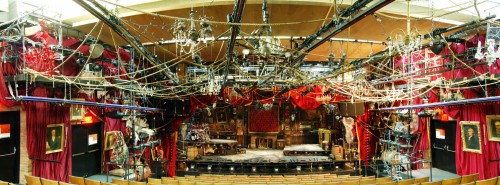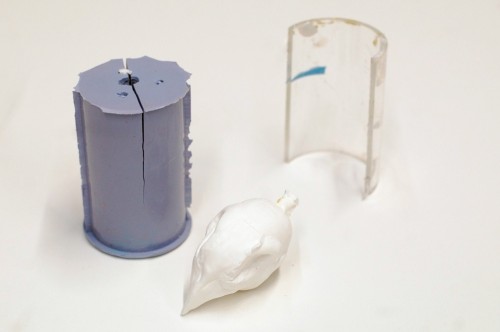Dear blog,
What a year it’s been!
But seriously, It’s hard to believe this blog has been running for three years already. I began a tradition where I would sum up the posts from the previous years, starting with the first 162 posts, followed by the next 151 posts. I’m now up to 461 posts, at a grand total of over 218,000 words. If you’ve been reading this blog for awhile, I would love to hear from you either in the comments or in an email; of course, if you’ve already left a comment in the past few years, feel free to leave another!

Probably the biggest news for me this year was that my book idea was picked up by Focal Press. It will be called The Prop Building Guidebook for Theatre, Film and TV and appear in bookstores in February, 2013. I submitted the first several chapters back in November, and my next partial deadline is this February. The other big news is that I left New York City to move to North Carolina.
I was interviewed by Angela Mitchell at About.com. I had two articles appear in Stage Directions this year. “From Agave to Zeus” was about the dead body and head we created for The Bacchae in 2009. “Intelligent Design” was about the breakaway wall(!) we made for The Intelligent Homosexual’s Guide to Capitalism and Socialism with a Key to the Scriptures.
Some of the feature articles I wrote just for this blog include a comparison of recipes for Scenic Dope and Monster Mud; what’s in a Prop Bible; why you should always be photographing; defining the scope of a project with Design Briefs; what is Pepakura; taking baby steps and jumping in; a brief discussion on period props; clearing up some confusions in the world of plastics; how Bad Props make Bad Shows; a union propmaker’s tool kit; product versus process; how your labor is a cost, not a profit; an imaginary conversation on whether the soldiers have swords or guns; how to work with what you have; making a fake newspaper; making fake but edible food; making fake drinks; a case against metric; and finding a job in film (for prop makers). Some of my articles deal with the important issue of safety as well. I wrote about safety goggles, the real dangers of MDF, how you should breathe nothing but air, and what happens when actors drink chemicals instead of fake drinks.
At the end of 2011, I shared what I felt was the top prop news of the year. I wrote about more news that happened, though what I wrote is more of what happens to me personally. Stories included a round-up of USITT 2011 in Charlotte, NC, a fire drill at the Public Theater, some new miracle materials, the 2011 Tony Award for Best Scenic Design, a tour of the Childsplay Theatre shops (see also part 2), Rebecca Akins’ work and speech at the 2011 S*P*A*M conference, how the backstage community helped out on September 11th, 2001, attending Maker Faire, guns seized on the set of Brad Pitt’s latest film project, and a salon discussion on “Being Green” in theatre.
Some of the projects I’ve worked on which I shared this year include a set of Art Deco footlights for Sleep No More, made on a homemade sheet metal brake; a set of chairs for an opera called Tea; food in Timon of Athens which I prop mastered at the Public Theater; letters for a Starbucks scene; Bloody Bloody Andrew Jackson; a Yoruban ceremonial sword; a new prop (a replica of a French 75mm artillery gun) for Shakespeare in the Park (one of my favorites); the set dressing in The Intelligent Homosexual’s Guide to Capitalism and Socialism with a Key to the Scriptures, props in King Lear at the Public Theater, including a fake dead pheasant; a severed hand in Titus Andronicus at the Public Theater, molded from Jay O. Sanders’ hand (one of my other favorites), and a cast iron park bench.
I sometimes make my own illustrations, and this year I shared the parts and types of a hammer, parts of a table, and the parts of a cigar, cigarette, pipe and matchbook. I also shared helpful illustrations by others which included the history of the US flag, analysis of a chair, Ancient Egyptian weapons, Ancient Greek helmets, Ancient Greek weapons, Ancient Roman weapons, theatrical ads from a hundred years ago, and olde time woodworking machines.
I also shared some videos: American Theatre Wing featured the prop master in their “In the Wings” series; the USITT 2011 Tech Olympics; Jim Henson making Muppets in 1969; a screen test video for snake puppets in Stargate SG-1; a Tour of an Animatronic Workshop; John Sanders and The Walking Dead props; Seán McArdle and Faye Armon; Props in True Grit; the NYC Christmas Windows; and the automaton in Hugo.
I continued reviewing books which I find useful for working in props. This year, these included A Guidebook for Creating Three-Dimensional Theatre Art by Ann J. Carnaby; the Backstage Handbook by Paul Carter and George Chiang; Grande Illusions 1 and 2 by Tom Savini; The Business of Theatrical Design by James L. Moody; The Complete Illustrated Guide to Joinery by Gary Rogowski; and one of the most important, The Health and Safety Guide for Film, TV and Theater by Monona Rossol.
Finally, I’m always exploring the history of props as it relates to the history of the theatre in general and the rest of the world. This past year, I took a look at the history of women in props, carpentry then and now, the history of props in Kabuki theatre, and more on Ancient Greek theatre props. I also asked some important questions like who invented the hot glue gun?  What is Celastic? Who was Thurston James? I also relayed some biographical information about Joe Lynn, the Tony Award–winning Props Master, and took a look at a man who may have been the first prop master in America. Finally, I shared some old humorous anecdotes about props.
Integral to exploring the history are the reprints of old book excerpts, magazine articles, and news stories from the dusty bins of prop history. This year’s catalog includes Joining a Circus in 1922, Property Resources from 1916, In the Boston Museum’s Prop Room in 1903, The Agonies of a Stage Manager in 1914, Recollections of Dirty Snow from 1916, David Belasco and Set Dressing from 1904, Concerning Stage Viands in 1910, How to be a Great, Not Just Good, Set Decorator (date unknown), A Property Man’s Confession in 1903, the Salaries of US Theatre in 1798, The Old Proproom at the Walnut St. Theatre of 1910, Shams in the Theatre in 1880, A Madman in a Theater from 1893, Rehearsing the “Props” in 1911, How nature is imitated on the stage circa 1885, No Screen for Rehearsal in 1903, Duties of  a Property Man in Utah in 1921, and lastly, a lengthy magazine article from 1878 split up into several parts: Evidence of Elizabethan Props, Props at Drury Lane in 1709 and Theatre Royal in 1776, Real Objects versus Constructed Props, Nineteenth Century Prop Lists, Skulls used in Hamlet, George Frederick Cooke’s Body as a Prop, and Macready and his Deer Skin.
As always, remember that you can subscribe to my blog with your favorite blog reader, or sign up to get all articles through email so you don’t miss anything in the future. I add three posts a week, and as a bonus, the RSS feed and email subscriptions remain advertisement-free.





